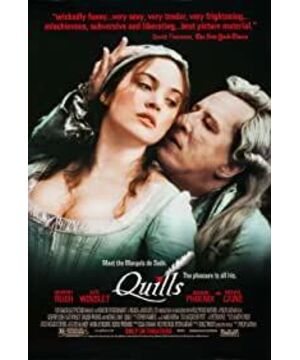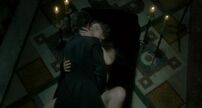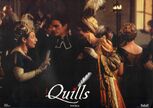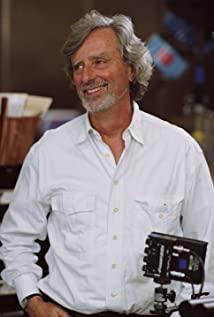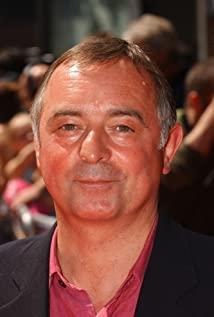First, the space narrative in the film The narrative space of the film "Quil" has played a key narrative role from the very beginning of the film. The story at the beginning of the film takes place in a public execution ceremony. A young and beautiful woman's hair fluttered in the cold wind and her eyes were blurred. After a close-up shot with a blurred background, the executioner behind the woman, the guillotine, and the people under the guillotine began to appear in front of the camera, showing the story from then on. The space where it takes place. Marquis Sade, who was writing in the room at this time, witnessed all this, the entire execution process, and the performance of the onlookers. At that time, the specific space of the guillotine itself had many meanings: the ceremony on the guillotine publicly displayed a prisoner's confession, the prisoner's public punishment was linked to the crime of the prisoner himself, and it made the perpetrator his own crime. the announcer. This public execution of a symbolic body of youth at the guillotine also implies the official suppression and elimination of sexuality, as well as the maintenance of its own authority and the discipline and suppression of the public. The rest of the film's storytelling is dominated by madhouses. It is worth noting that the lunatic asylum in the film is a complex piece in terms of its mechanics and function. In the early days, the insane asylum was a loose confinement place for the Marquis of Sade, or, similar to a sanatorium with moral isolation, in which Sade was able to create a lot of erotic works. When Sade rehearsed the stage play for the lunatic in the hospital, the lunatic asylum was full of various elements of a mental hospital in the modern sense. The priest, as an incarnation of morality, gave calm and compassionate guidance to the lunatic. When Dr. Loiree Colabi gave special treatment to the lunatic, especially Sade, the lunatic asylum was more like a rough and dark place of confinement. At the end of the film, the doctor organizes the asylum into a small production factory, a model of a modern prison in transition. The setting and application of typical spaces such as the headstage and the madhouse in the movie "Quil" serves as a film language to serve the narrative of the entire film, subtly supplements the background information that is difficult to provide in the film's audio-visual language, and also serves as a source for the entire film. The rationale of the narrative provides the basis. Second, the arrangement of events in the movie The script of the movie "Quil" is based on the real character Sade in history, adapted and fictionalized from his deeds. Director Kaufman successfully created a new image of Marquis de Sade with his superb film narrative techniques. Here comes the question of film writers. In 1948, the French director As Truck put forward his famous proposition: "Camera - Fountain Pen", arguing that the person in charge of the film camera should "write" as freely and freely as the author who writes the pen. In this film, the screenwriter Wright collected and transformed the real story of Sade when writing the script, while the director Kaufman recreated the script when he was narrating the film. In the process of switching the script text narrative into the film narrative, the director must go through his own subjective creation, so the director plays a key role in the successful expression of the film. The main body of the film script selects Sade's life in the Charenton mental hospital in his later years as the background, with his thoroughly subversive critical thinking as the main theme of the film, and auxiliaryly adds the marriage relationship between Sade and his wife, the "guillotine". The experience of "down" and the struggle with those in power, etc., are assembled into a relatively complete fragmented story. Because the film is a biographical fictional drama, Kaufman takes the portrayal of Sade as the core in Quill, and adopts a traditional linear narrative structure. The relationship line (or narrative line) of the primary and secondary characters unfolds linearly, and affects each other and has a comprehensive effect. The main relationship lines are: the marquis and the writing, the marquis and the laundress, the doctor and the wife, and the laundress and the priest. The narrative branches include the priest (the continuation of the marquis) and writing, the washerwoman and the blind mother (the continuation of the washerwoman) and the priest, the doctor's wife and the architect, the washerwoman and the connector, etc. While the main line is advancing, they are related to each other, and the sub-line narratives add details, making the images of the main characters such as the marquis, doctors, and priests more vivid. However, the shortcomings of such a narrative are also obvious. Concentrating on creating the core character, Marquis de Sade, leads to insufficient narration of other narrative lines. For example, the relationship between the priest and the laundress is handled more jumpily, which leads to the substantive nature of the priest in the climax narrative unit of the film. The image display or unveiling is not thorough enough, which makes the continuation of the priest's writing to the Marquis in the ending narrative unit of the film relatively weak. The film's carefully selected materials and narrative event arrangement enable the film to successfully shape the core characters as the purpose and express the theme of the work, but the arrangement and narrative of the primary and secondary inevitably lead to the inequality between the discourse subjects in the work. Form a subtle logical break. Third, the expression of the film's theme The film "Quil" is based on the Sade incident, and is re-created by Sade's own subversive thoughts in history. Regarding the historical Sade, here is the evaluation of sociology scholar Li Yinhe: "Whether in the private sphere or in the public sphere, Sade is more revolutionary and subversive than Freud, so he is regarded as A threat to the entire social body. He is a challenge to the established sexual order... ...he is a violent attack on the existing social foundations. His works have been banned for a long time, and because he spurned public decency, he opened Pandora's box and poured venom on society. ” As the “prototype” of Marquis Sade in the film, Sade’s own ideas are strongly revolutionary and subversive. The film uses metaphorical hints such as “Quil” and “Storm in the Inkwell”. Expose this real situation, and creatively deviate the theme of the work through its own narrative: The film displays key and meaningful words in the first narrative unit: "Who doesn't dream of indulging in every The shudder of orgasm, satisfying every wicked thirst? "This criminal who holds people's universal needs was brutally castrated by the executioner who symbolizes the extreme rationality and represents the regime's repression of individual freedom and passion. This narrative unit has already said everything, and the following narrative is about this The confirmation and use of the theme. Therefore, there will be dialogue lines like this in the film: "(The Count) But in order to understand virtue, we must acquaint ourselves with evil. Only then can we know the whole of humanity. "Piercing through the moral hypocrisy of the authorities, re-understanding people, and rediscovering virtue. Where reason transgresses, it is the reason for the existence of passion. This new theme formed after the theme deviation of the unique narrative of the film serves the film again. The shape of the core characters in the film; this deviation is the deepening of the expression of the work itself, but also the deepening of the thinking of the Marquis de Sade in the film, and the increase in the thickness of the characters means the upgrade of the entire film. By choosing typical space as the film language, the film's narrative content is fuller and the film's hidden information is increased; the careful arrangement of events has successfully shaped the core character of the Marquis de Sade, and also completed the role of the film itself. The establishment of an independent film art work. References: [1] Dai Jinhua. Film Theory and Criticism [M]. Peking University Press. 2007. Society. 2010. [3] (French) Maurice LeVert; Zheng Dahua, translated by Xu Ningyan. Sade Biography [M]. Beijing: China Social Sciences Press. 2002. [4] (French) Michel · Foucault; Liu Beicheng, translated by Yang Yuanying. Madness and Civilization [M]. Beijing: Sanlian Publishing House. 2019. [5] (France) Michel Foucault; Liu Beicheng, translated by Yang Yuanying. Discipline and Punishment [M] .Beijing: Sanlian Publishing House. 2019. [6] Thomas Leach, Wang Zhao. Hitchcock and his screenwriters: Author Theory and Adaptation Authority [J]. Film Art,
View more about Quills reviews


